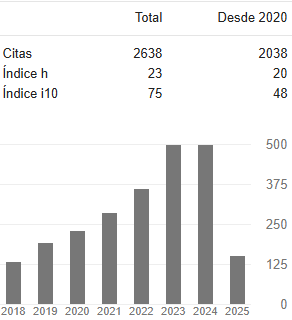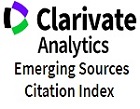Modelado de la energía de interacción de nanopartículas de sílice preparadas en microemulsiones
DOI:
https://doi.org/10.31908/19098367.566Palabras clave:
estabilidad coloidal, nanopartículas, sílice, microemulsiones, teoría DLVOResumen
Se modeló la energía de interacción de nanopartículas de sílice preparadas en microemulsiones de fase orgánica, usando la teoría DLVO para partículas esféricas de igual tamaño. Los surfactantes comerciales seleccionados fueron la sal sódica del sulfosuccinato de bis-(2-etilhexilo) (AOT) y Tritón X-100 [p-(1, 1, 3,3-tetrametilbutil) fenílico] (TX100). Los sistemas coloidales estudiados fueron ciclohexano/ AOT, ciclohexano/TX-100, isooctano/AOT, e isooctano/TX100. Las curvas de energía total de interacción se construyeron para varios diámetros de nanopartículas en función de su distancia de separación. Los resultados fueron comparados con la energía termal del sistema, encontrando mayor estabilidad coloidal para el modelo de nanopartículas de sílice cubiertas con el surfactante TX-100 y suspendidas en ciclohexano. Por último se esperaría que la combinación de los compuestos químicos ciclohexano/TX-100 permita la formación de micelas inversas que sirvan tanto para la formación de nanopartículas de sílice proporcionando un medio para el control de tamaño, así como un sistema con buena estabilidad coloidal.
Descargas
Referencias
K. Margulis-Goshen, and K. Magdassi, Organic nanoparticles from microemulsions: Formation and applications, Current Opinion in Colloid & Interface Science vol. 17, no.5., pp. 290-296, Oct. 2012.
M. Ahmad, M. Younus, and M. Ali, Microemulsion method: A novel route to synthesize organic and inorganic nanomaterials: 1st Nano Update, Arabian Journal of Chemistry, vol. 5, no.4. pp. 397–417, Oct. 2012.
C. Barrera, A. P. Herrera, N. Bezares, E. Fachini, R. Olayo-Valles, J. P. Hinestroza, and C. Rinaldi, Effect of poly(ethylene oxide)-silane graft molecular weight on the colloidal properties of iron oxide nanoparticles for biomedical applications, Journal of colloid and interface science, vol. 377, no.1., pp. 40-50. Jul. 2012.
S. R. Rao, Surface Chemistry of Froth Flotation, Vol. I, New York, Fundamentals Springer Science & Business, Kluwer Academic/ Plenium Publishers, 2013, pp. 15-17.
A. Herrera, O. Resto, J. G. Briano, and C. Rinald, Synthesis and agglomeration of gold nanoparticles in reverse micelles, Nanotechnology, vol. 16, no.7., pp. 618-625, Jun. 2005.
C. H. Achebe, and S. N. Omenyi, Mathematical Determination of the Critical Absolute Hamaker Constant of the Serum (As an Intervening Medium) Which Favours Repulsion in the Human Immunodeficiency Virus (HIV)-Blood Interactions Mechanism, Proceedings of the World Congress on Engineering Vol II, London, U.K, 2013.
N. Jaramillo, C. Paucar, and C. García, Influence of the reaction time and the Triton x-100/Cyclohexane/Methanol/HO ratio on the morphology and size of silica nanoparticles synthesized via sol-gel assisted by reverse micelle microemulsion, Journal of Materials Science vol. 49, no.9, pp. 3400-3406, May. 2014.
K. In-Yong, E. Joachim, H. Choi, and K. Kim, K, Toxicity of silica nanoparticles depends on size, dose, and cell type. Nanomedicine: Nanotechnology, Biology and Medicine vol. 11, no.6, pp. 1407–1416. Aug. 2015.
M. C. Llinás, and D. Sánchez-García, Nanopartículas de sílice: preparación y aplicaciones en biomedicina, Afinidad vol. 71, no.565, pp. 20-31, Dic. 2014.
V. Médout-Marére, A Simple Experimental Way of Measuring the Hamaker Constant A11 of Divided Solids by Immersion Calorimetry in Apolar Liquids, Journal of Colloid and Interface Science, vol. 228, no.2, pp. 434–437, Aug. 2000.
S. Eichenlaub, C. Chan, and S. P. Beaudoin, Hamaker Constants in Integrated Circuit Metalization, Journal of Colloid and Interface Science, vol. 248, pp. 389–397, Apr. 2002.
J. B. Rosenholm, K. E. Peiponen, and E. Gornov, Materials cohesion and interaction forces, Advances in Colloid and Interface Science, vol. 141, no.(1–2), pp. 48–65, Sep. 2008.
T. F. Tadros, Rheology of Dispersions Principles and Applications, Wiley-VCH, United Kingdom, 2011, p. 25.
R. Porcel, A. B. Jódar, M. A. Cabrerizo, R. Hidalgo-Alvarez, and A. Martín-Rodríguez, Sequential Adsorption of Triton X-100 and Sodium Dodecyl Sulfate onto Positively and Negatively Charged Polystyrene Latexes, Journal of Colloid and Interface Science, vol. 239, pp. 568–576, Jul. 2001.
M. A. La-Scalea, C. M. S. Menezes, and E. I. Ferreira, Molecular volume calculation using AM1 semi-empirical method toward diffusion coefficients and electrophoretic mobility estimates in aqueous solution, Journal of Molecular Structure: THEOCHEM, vol. 730, no.1, pp. 111-120, Oct. 2005.
A. R. Mustafina, J. G. Elistratova, O. D. Bochkova, V. A. Burilov, S. V. Fedorenko, A. I. Konovalov, and S. Y. Soloveva, “Temperature induced phase separation of luminescent silica nanoparticles in Triton X-100 solutions,” Journal of colloid and interface science, vol. 354, no.2, pp. 644-649. Feb. 2011.
L. P. Singh, S. K. Bhattacharyya, R. Kumar, G. Mishra, U. Sharma, G. Singh, and S. Ahalawat, Sol-Gel processing of silica nanoparticles and their applications. Advances in colloid and interface science, vol. 214, pp. 17-37, Dec. 2014.
C. Barrera, A. P. Herrera, and C. Rinaldi, “Colloidal dispersions of monodisperse magnetite nanoparticles modified with poly (ethylene glycol),” Journal of colloid and interface science, 329(1), 107-113, Jan. 2009.
A. A. Araújo, E. L. Barros, O. C. Filho, y E. L. Foletto, “Determinación de los parámetros del modelo de flory-huggins para estimación del punto de nube de surfactantes no iónicos,” Información Tecnológica, vol. 25, no.2, pp. 165-174, Dic. 2014.
Descargas
Publicado
Número
Sección
Licencia
Derechos de autor 2019 Entre Ciencia e Ingeniería

Esta obra está bajo una licencia internacional Creative Commons Atribución-NoComercial 4.0.



















